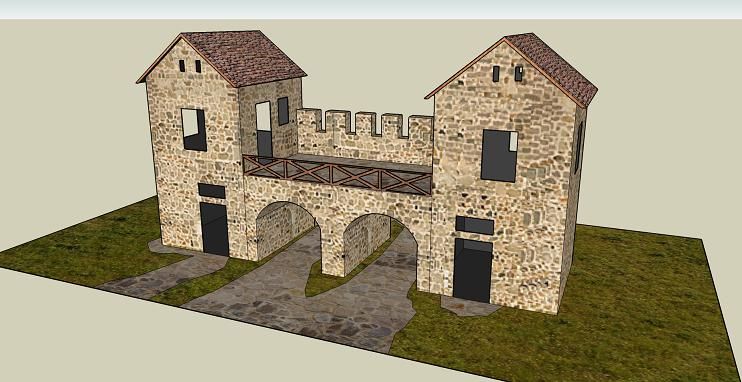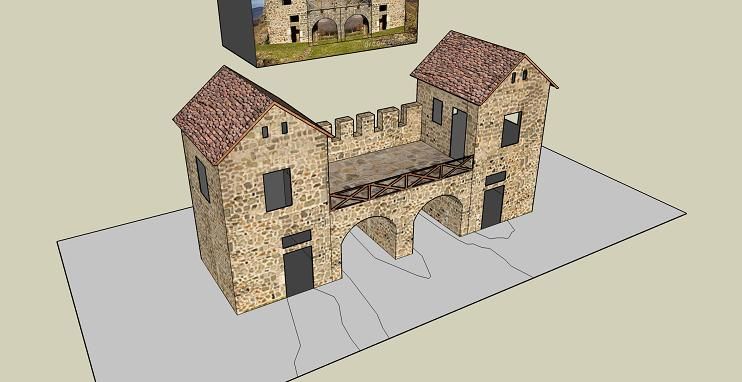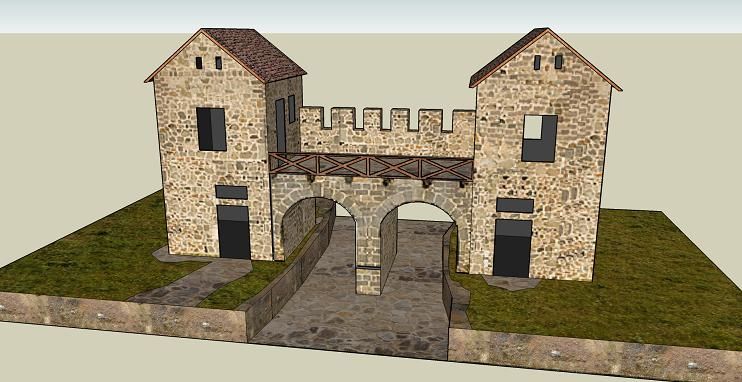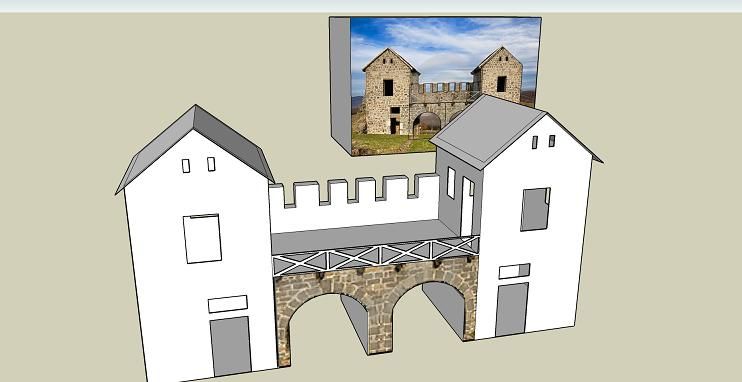Wednesday, October 12, 2011
Halloween Special - Haunted Mansion And Monsters - by Ray O`Bannon
RavensBlight Manor is a very unusual old ruin. Much dryer and weathered than it should be on the outside, far damper and colder than it should be on the inside...rumored to bring ruin to anyone involved with it...and now it can be YOURS! The assembly instructions and all the parts are listed below. Just click each page, print out the parts, and build your own spooky little paper nightmare! Does your Ghost House model need a few occupants?
Does your Battle-Hearse need a zombie to smash?
Perhaps the mortician from your Hearse Playset just needs someone to chat with? Here are some miniature monstrosities to solve all the problems listed above.- Ray O`Bannon
Link: Halloween.Special.Haunted.Mansion.by.Ray.O`Bannon
Link: Halloween.Special.Monsters.Set.by.Ray.O`Bannon
More Haunted Houses related posts:
Halloween Special - Bates House - by Haunted Dimensions
Halloween Special - Phantom Manor - by Ray Keim
Halloween Special - Haunted House - by Angels & Ghosts.Com
Marcadores:
architecture,
building,
download,
halloween,
horror,
papermodel
Balinese Legong Dancers - by Julius Perdana - Dançarinas de Bali
More one great model by Julius Perdana, from Paper-Replika.
Mais um belo modelo de Julius Perdana, do site Paper-Replika.
Legong is a classical Balinese dance, originally it always performs by a pair of dancers who are two young girls that never have menstruation yet. The word Legong comes from a word Leg, which mean slow dance movement in balinese. It is characterised by highly stylised slow movements. Its delicacy is heightened by the fact that is performed by richly costumed young dancers, sometimes only four years old, many of whom retire at the tender age of 18. The word Legong firstly announced to western public was through a silent movie by an American director titled Legong: Dance of the Virgins in 1935 in New York Theater. That movie was made on Bali island in 1933, all cast are from that island of gods natives. However, Legong dance was rediscovered and maintained by Indonesian goverment on early 1960. - Julius Perdana
Legong é uma dança característica de Bali, que tradicionalmente é feita por um par de dançarinas muito jovens, que ainda não menstruaram. A palavra Legong significa "dança com movimentos lentos". essa delicadeza é realçada pelos trajes ricamente decorados das jovens dançarinas, muitas vezes com idades a partir de 4 anos. O Ocidente ouviu falar do Legong pela primeira vez em 1935, através de um filme feito em Bali, por um cineasta americano. - Julius Perdana.
Link: Balinese.Legong.Dancers.by.Julius.Perdana
More Tradition, Myth and Culture related posts:
Maiko, Aprenttice Geisha Bust - by Mugi - Maiko, Gueixa Aprendiz
Hindu Myth Paper Model - by PDF Land - Mito Hindú Da Criação
Bali’s Queen Of Witches - by Salazar - Rainha das Bruxas de Bali
Mais um belo modelo de Julius Perdana, do site Paper-Replika.
Legong is a classical Balinese dance, originally it always performs by a pair of dancers who are two young girls that never have menstruation yet. The word Legong comes from a word Leg, which mean slow dance movement in balinese. It is characterised by highly stylised slow movements. Its delicacy is heightened by the fact that is performed by richly costumed young dancers, sometimes only four years old, many of whom retire at the tender age of 18. The word Legong firstly announced to western public was through a silent movie by an American director titled Legong: Dance of the Virgins in 1935 in New York Theater. That movie was made on Bali island in 1933, all cast are from that island of gods natives. However, Legong dance was rediscovered and maintained by Indonesian goverment on early 1960. - Julius Perdana
Legong é uma dança característica de Bali, que tradicionalmente é feita por um par de dançarinas muito jovens, que ainda não menstruaram. A palavra Legong significa "dança com movimentos lentos". essa delicadeza é realçada pelos trajes ricamente decorados das jovens dançarinas, muitas vezes com idades a partir de 4 anos. O Ocidente ouviu falar do Legong pela primeira vez em 1935, através de um filme feito em Bali, por um cineasta americano. - Julius Perdana.
Link: Balinese.Legong.Dancers.by.Julius.Perdana
More Tradition, Myth and Culture related posts:
Maiko, Aprenttice Geisha Bust - by Mugi - Maiko, Gueixa Aprendiz
Hindu Myth Paper Model - by PDF Land - Mito Hindú Da Criação
Bali’s Queen Of Witches - by Salazar - Rainha das Bruxas de Bali
Marcadores:
character,
culture,
download,
figure,
indonesian,
papermodel
Abandoned Gas Station`s Old Furgon Truck - by Papermau
Here an old furgon truck, to use in Abandoned Gas Station`s diorama. There are ten colors in the .rar file. Later I will make a tow truck version.
Aqui um velho caminhão de entregas, que pode ser estilizado para ser um caminhão de mecânico. Perfeito para se usar no diorama do Posto de Gasolina Abandonado. Mais para frente farei a versão de caminhão guincho na mesma escala.
Link: Abandoned.Gas.Station`s.Old.Furgon.Truck.by.Papermau
More Gas Stations related posts:
Vintage Service Station - by Papermau - Posto de Gasolina Vintage
Route 66 Abandoned Gas Station - by Papermau - Download Now!
Joe`s Garage - by Papermau - Garagem Do Joe
Aqui um velho caminhão de entregas, que pode ser estilizado para ser um caminhão de mecânico. Perfeito para se usar no diorama do Posto de Gasolina Abandonado. Mais para frente farei a versão de caminhão guincho na mesma escala.
Link: Abandoned.Gas.Station`s.Old.Furgon.Truck.by.Papermau
More Gas Stations related posts:
Vintage Service Station - by Papermau - Posto de Gasolina Vintage
Route 66 Abandoned Gas Station - by Papermau - Download Now!
Joe`s Garage - by Papermau - Garagem Do Joe
Marcadores:
car,
download,
exclusive,
papermodel,
vehicle
Commodore SX-64 First Portable PC - by Erik Schubach
| The Real Thing |
The SX-64 features a built-in five-inch composite monitor and a built-in 1541 floppy drive. It weighs 10.5 kg (23lb). The machine is carried by its sturdy handle, which doubles as an adjustable stand. It was announced in January 1983 and released a year later, at US$ 995.
O Commodore SX-64, também conhecido como Executive ou VIP-64 em outros países, foi um dos primeiros computadores pessoais portáteis. Dobrável, ele se transformava em uma maleta de 10 quilos (?!?) e trazia o sistema operacional Commodore Basic 2.0. Quando foi lançado, em 1984, o computador custava 995 dólares. Foi também o primeiro portátil a ter uma tela colorida, de 5 polegadas.
Link: Commodore.SX-64.First.Portable.PC.by.Erik.Schubach
More Inventions related posts:
Apple I and Apple II PCs - by Julius Perdana - Paper-Replika
Da Vinci`s Mechanical Hammer - by Paper Pino - Martelo de Da Vinci
Marcadores:
computers,
download,
papermodel,
science
Tuesday, October 11, 2011
Bamboo Blade Anime Paper Dolls - by A C Gateway
Bamboo Blade is a Japanese manga series written by Masahiro Totsuka, and illustrated by Aguri Igarashi. The manga was first serialized in the Japanese seinen manga magazine Young Gangan starting December 3, 2004. An anime adaptation was broadcast in Japan between October 2, 2007 and April 2, 2008 on TV Tokyo. The series tells the story of Toraji Ishida, a luckless high school Kendo instructor, who is challenged by his former upperclassman, also a kendo instructor, to a competition between their female students. The bet inspires Toraji to gather and train a team of five girls. Fortuitously, at this time he meets Tamaki Kawazoe, a gifted young female kendo practitioner. - Wikipedia
Bamboo Blade conta o dia-a-dia de um clube escolar de kendo. O clube tem como treinador o azarado professor Toraji Ishida que, no começo do anime, enfrenta uma crise, pois apenas um membro do clube está em atividade. Inicialmente a série mantém o foco na luta do clube pela sobrevivência, já que, para existir, é preciso ter uma quantidade mínima de membros. Aos poucos o grupo vai sendo formado, e é aí que a coisa esquenta: os personagens da série são extremamente cativantes. Sobre o enredo de Bamboo Blade não há muito o que dizer. É quase um ”slice of life“, acompanhando a vida dos membros do clube em seus treinamentos e campeonatos. É um anime muito gostoso de ser assistir, dono de um clima muito bem humorado, de um ritmo perfeito e que apresenta situações muito engraçadas. A série também conta com alguns momentos sérios, já que todos os personagens possuem algum problema ou frustração. - animehaus.com.br
Link: Bamboo.Blade.Anime.Paper.Dolls.by.A.C.Gateway
More Paper Dolls related posts:
Sophitia - Japanese Paper Doll - by Rokunoya
Bamboo Blade Anime Paper Dolls - by A C Gateway
Ruri Ruri Paper Doll Anime Style - by Moekami - Boneca Estilo Anime
Marcadores:
anime,
download,
japanese,
paper doll,
papermodel
Roman Castrum In Romania - by Papermau - Second Part
Just to remember, in the first post, I`ve stoped here:


More some images of the development of this model, captured from Sketchup :


The next step is to separate the various parts of the model, and then unfold it in Pepakura.
O próximo passo é separar as várias peças do modelo, para depois desdobrar no Pepakura.
Soon.
More Roman Castrum In Romania related post:
Roman Castrum In Romania - by Papermau - First Part


More some images of the development of this model, captured from Sketchup :


 |
| And in these last three images, you can see the development of the base, with the lower gate passage. |
The next step is to separate the various parts of the model, and then unfold it in Pepakura.
O próximo passo é separar as várias peças do modelo, para depois desdobrar no Pepakura.
Soon.
More Roman Castrum In Romania related post:
Roman Castrum In Romania - by Papermau - First Part
Marcadores:
architecture,
building,
exclusive,
papermodel,
roman
Sci-Fi Series Stargate M.A.L.P. Vehicle - by Laul
This M.A.L.P. vehicle from Stargate, very detailed and with incredible textures, was made by Laul, a great French designer. You can see more Sci-Fi paper models in his page, to download for free.
| Stargate Crew - Do You Know Who Was McGyver? |
M.A.L.P.s come in various configurations and equipment. For example, the original device used when the Earth gate was first activated ran on all-terrain treads, while the newer models used by Stargate Command run on six heavy-duty wheels. - www.gateworld.net
Stargate is a military science fiction franchise, initially conceived by Roland Emmerich and Dean Devlin. The first film in the franchise was simply titled Stargate. It was originally released on October 28, 1994, by Metro-Goldwyn-Mayer and Carolco, and became a hit, grossing nearly $200 million (USD) worldwide. Three years later, Brad Wright and Jonathan Glassner created a television series titled Stargate SG-1 as a sequel for the film.
| The "Real" Thing |
Na indústria do entretenimento, o termo Stargate refere-se às produções americanas de ficção científica (do gênero "Space Opera") que tiveram início com o longa-metragem para o cinema Stargate, em 1994, e que hoje incluem três mini séries: Stargate SG-1 (1997-2007 - 10 temporadas), Stargate Atlantis (2004-2009 - 5 temporadas), Stargate Universe (2009-2011 - 2 temporadas), uma telessérie de animação e diversos romances e outras fontes, de modo a formar um extenso universo ficcional. - Wikipedia
Uma curiosidade: O ator que faz o papel principal do 1º seriado Stargate, é Richard Dean Anderson, o eterno McGyver, da série homônima dos anos 80.
Link: Sci-Fi.Series.Stargate.M.A.L.P.Vehicle.by.Laul
More Sci-Fi related posts:
Star Wars - X-Wing Starfighter - by J. Leslie
Sci-Fi Space Ships - by Pierre Fontaine - Naves Espaciais
Gun Walker Combat Vehicle - by Shunichi Makino
Marcadores:
car,
download,
papermodel,
sci-fi,
vehicle
Great Torii of Itsukushima In Japan - by Bernard Buzuc - Grande Torii
This cool and unusual model was made by Bernard Buzuc, a great French designer and paper model enthusiast and is originally posted at Le Forum Em Papier, one of the best European paper model forums.
| The Real Thing |
Built on axis with the sea-facing shrine, the gate serves to welcome spirits of the departed as they come in across the water of Japan's Inland Sea. At low tide, visitors walk around the great columns of the structure, measuring its great size against the human body. At high tide, the rugged vermillion gateway seems to float in the waves around it, a gateway for boats, or for spirits indeed. - Kevin Matthews
Itsukushima Shrine is a Shinto shrine on the island of Itsukushima (popularly known as Miyajima) in the city of Hatsukaichi in Hiroshima Prefecture in Japan. The shrine complex is listed as a UNESCO World Heritage Site and the Japanese government has designated several buildings and possessions as National Treasures.
Este belo e incomum modelo foi feito por Bernard Buzuc, um grande modelista francês e entusiasta do papel modelismo. Ele está postado originalmente no Forum Em Papier, um dos melhores foruns europeus sobre paper models.
| The Torii At Low Tide |
Considerado pelos japoneses como um dos três cenários mais bonitos do país, o Torii do Santuário Itsukushima parece flutuar na água. O chefe militar Taira no Kiyomori, que doou fundos para o santuário, construiu o primeiro Torii naquela baía, no século XII. A estrutura atual data de 1875 e tem cerca de 16 metros de altura.
O Santuário de Itsukushima é um santuário xintoísta situado na ilha de Itsukushima, perto da cidade de Hatsukaichi, na província de Hiroshima, no Japão, que foi construído sobre as águas. Foi considerado Património Mundial da Humanidade pela UNESCO em 1996 e está protegido por severas leis de proteção do património japonês.
| The Temple Seen From The Torii |
Link: Great.Torii.of.Itsukushima.In.Japan.by.Bernard.Buzuc
More Japanese Traditional Architecture related posts:
Takadono Tatara - Old Steel Industry - by Sugatani
Japanese Pagoda - by Otonchin.Soreccha.JP - Pagode Japonês
Japanese Buildings - by Nostalgic Work Club - Lojinhas Japonesas
Marcadores:
ancient,
architecture,
building,
download,
japanese,
papermodel,
religion
Monday, October 10, 2011
Micro Scale French Train TGV - by Rail Fan Europe
More than fourty models of TGV French trains, by Rail Fan Europe, im 1/140 scale.
| The Real Thing |
At mid 2011, the TGV is the fastest conventional train in the world, reaching 320 km/h (200 mph) on the "LGV Est". - Wikipedia
| Australian Speedrail |
O TGV Paris-Estrasburgo circula a uma velocidade máxima de 320 km/h, ou seja, vinte quilómetros por hora mais rápido do que as outras linhas TGV em atividade na França. - Wikipedia
Link: Micro.Scale.French.Train.TGV.by.Rail.Fan.Europe
More Trains related posts:
Brazilian Touristic Express - by CPTM - Expresso Turístico
Mitake Mountain Cable Car - by Keio - Bonde da Montanha Mitake
Deshler Tower Paper Model - by Dan Merkel - Torre Ferroviária
Marcadores:
australian,
download,
french,
papermodel,
train
The Three Wise Hearts - by Phil Creations - Os Três Corações Sábios
Three Wise Hearts are a twist of the old Three Wise Monkeys (see no evil, hear no evil, speak no evil). I thought it was better to focus on the solution rather than the problem... - Phil Creations
The Three Wise Monkeys , sometimes called the Three Mystic Apes, are a pictorial maxim. Together they embody the proverbial principle to "see no evil, hear no evil, speak no evil". The three monkeys are Mizaru, covering his eyes, who sees no evil; Kikazaru, covering his ears, who hears no evil; and Iwazaru, covering his mouth, who speaks no evil. Sometimes there is a fourth monkey depicted with the three others; the last one, Shizaru, symbolizes the principle of "do no evil". He may be shown crossing his arms. There are various meanings ascribed to the monkeys and the proverb including associations with being of good mind, speech and action. In the Western world the phrase is often used to refer to those who deal with impropriety by looking the other way, refusing to acknowledge it, or feigning ignorance. - Wikipedia
Uma interpretação muito própria dos Três Macacos Sábios. " Não vejo o mal, não ouço o mal, não falo mal."
Os Três Macacos Sábios ilustram a porta do Estábulo Sagrado, um templo do século XVII localizado no Santuário Toshogu, na cidade de Nikko, Japão. Sua origem é baseada em um trocadilho japonês. Seus nomes são mizaru (o que cobre os olhos), kikazaru (o que tapa os ouvidos) e iwazaru (o que tapa a boca), que é traduzido como não ouça o mal, não fale o mal e não veja o mal. A palavra saru, em japonês, significa macaco e tem o mesmo som da terminação verbal zaru, que está ligado à negação.
O folclore japonês diz que a imagem dos macacos foi trazida por um monge budista chinês, no século XVIII. Apesar disso, não há comprovação dessa suposição. - Wikipedia
Link: The Three Wise Hearts - by Phil Creations
More Japanese Traditions related posts:
Nikko Tosho-gu Shrine - by Kids Net - Santuário Japônes
Hinakazari Japanese Decoration - by Canon - Decoração Japonesa
Traditional Japanese Food - by paperm.jp - Comida Japonesa
Subscribe to:
Posts (Atom)






